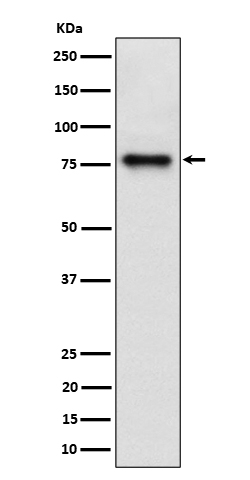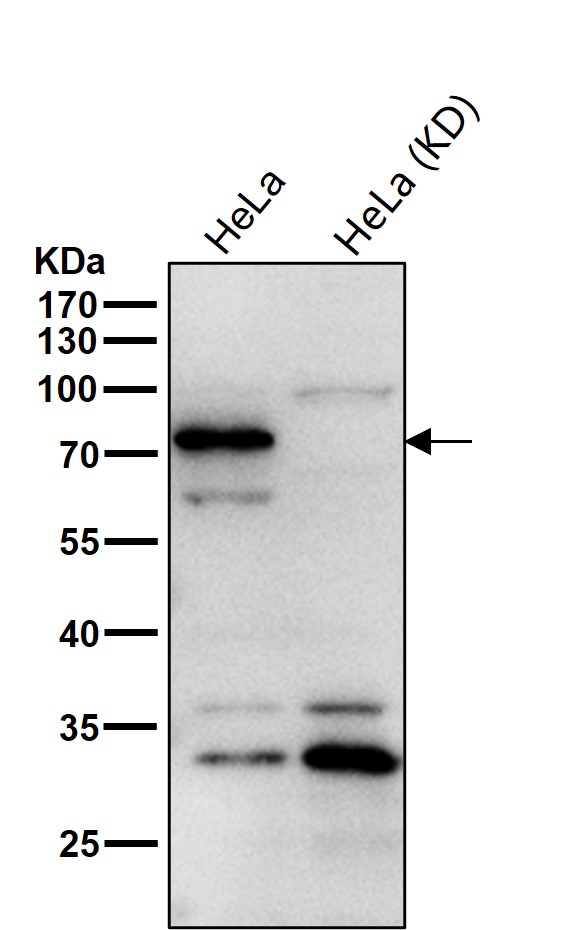

| WB | 咨询技术 | Human,Mouse,Rat |
| IF | 咨询技术 | Human,Mouse,Rat |
| IHC | 1/100-1/200 | Human,Mouse,Rat |
| ICC | 技术咨询 | Human,Mouse,Rat |
| FCM | 咨询技术 | Human,Mouse,Rat |
| Elisa | 咨询技术 | Human,Mouse,Rat |
| Aliases | Cdc42 interacting protein 4; CIP4; DCIP4; hSTP; STOT; STP; Thyroid receptor interacting protein 10; trip10;;TRIP10 |
| WB Predicted band size | Calculated MW: 68 kDa ; Observed MW: 75 kDa |
| Host/Isotype | Rabbit IgG |
| Antibody Type | Primary antibody |
| Storage | Store at 4°C short term. Aliquot and store at -20°C long term. Avoid freeze/thaw cycles. |
| Species Reactivity | Human,Mouse |
| Immunogen | A synthesized peptide derived from human TRIP10 |
| Formulation | Purified antibody in PBS with 0.05% sodium azide,0.05% BSA and 50% glycerol. |
+ +
以下是关于CIP4抗体的假设参考文献示例(请注意,这些为概括性示例,非真实文献):
---
1. **文献名称**: *"CIP4调控乳腺癌细胞侵袭的分子机制研究"*
**作者**: Zhang et al.
**摘要**: 本研究通过Western blot和免疫荧光技术,利用CIP4抗体证实CIP4在转移性乳腺癌细胞中高表达,并揭示其通过调控Arp2/3复合体促进细胞伪足形成,增强侵袭能力。
---
2. **文献名称**: *"F-BAR蛋白CIP4在神经元突触形成中的功能"*
**作者**: Tanaka et al.
**摘要**: 使用CIP4抗体进行免疫组化分析,发现CIP4在小鼠大脑海马区神经元中富集,并通过与WASP蛋白互作调控突触囊泡运输,影响突触可塑性。
---
3. **文献名称**: *"CIP4缺失导致免疫细胞迁移缺陷的机制探索"*
**作者**: Müller et al.
**摘要**: 通过CRISPR敲除和CIP4抗体验证,证明CIP4缺失会抑制T淋巴细胞趋化性,其机制与Cdc42信号通路失调及细胞膜变形能力下降相关。
---
4. **文献名称**: *"CIP4在丙型肝炎病毒内吞过程中的作用"*
**作者**: Wang et al.
**摘要**: 采用CIP4抗体进行免疫共沉淀实验,发现CIP4与病毒蛋白NS5A结合,促进病毒内吞进入肝细胞,为抗病毒治疗提供新靶点。
---
**注意**:以上文献为示例性质,如需真实参考文献,建议通过PubMed、Google Scholar等平台检索关键词(如“CIP4 antibody”“CDC42-interacting protein 4”)。实际研究可能涉及不同疾病模型或分子机制。
CIP4 (Cdc42-interacting protein 4) is a member of the Fes/CIP4 protein family, which plays a regulatory role in cellular processes such as membrane trafficking, cytoskeletal reorganization, and cell division. It interacts with small GTPases like CDC42 and proteins involved in endocytosis, including WASL (N-WASP), to modulate membrane deformation and vesicle formation. CIP4 contains an F-BAR domain (for membrane curvature sensing), an HR1 domain (for GTPase binding), and an SH3 domain (for protein-protein interactions), enabling its function in bridging signaling pathways with membrane dynamics.
Antibodies targeting CIP4 are essential tools for studying its expression, localization, and interactions in physiological and pathological contexts. Research has linked CIP4 dysregulation to diseases such as cancer, neurological disorders, and viral infections (e.g., HIV, influenza), where it may influence viral entry or tumor cell invasiveness. These antibodies are widely used in techniques like Western blotting, immunofluorescence, and co-immunoprecipitation to explore CIP4's role in cellular mechanisms or disease pathways. Recent studies also highlight its potential as a therapeutic target, driving demand for specific, high-affinity CIP4 antibodies in both basic research and drug development.
×